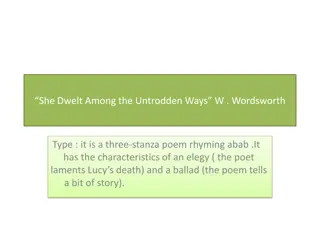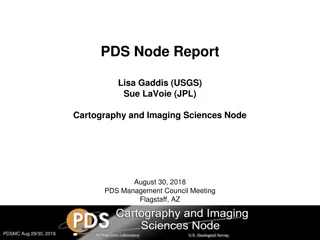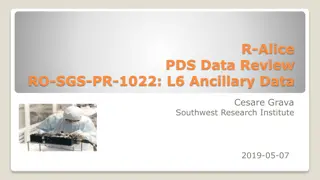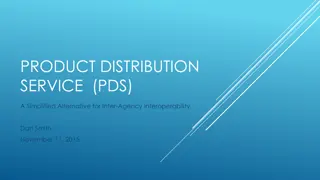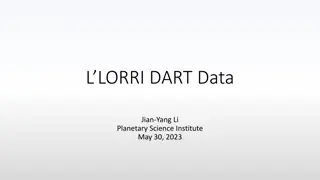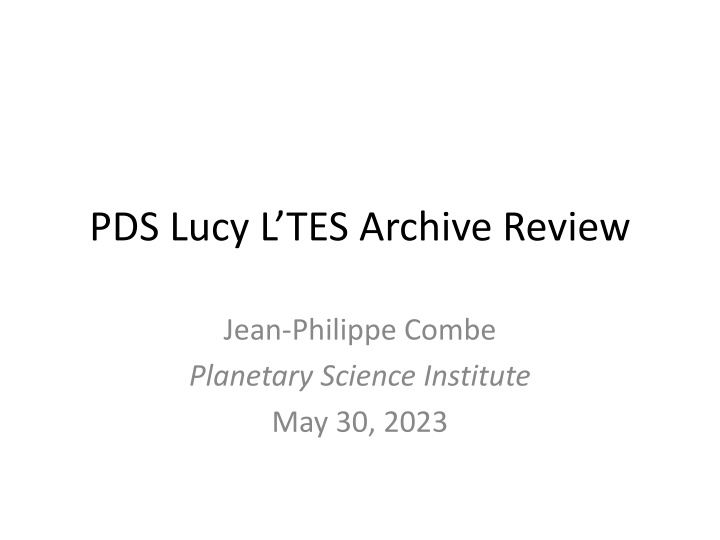
Lucy LTES Archive Review at Planetary Science Institute
Explore the review of L.TES data samples at the Planetary Science Institute, focusing on metadata, documentation, and pipeline performance. Dive into the challenges and insights of reviewing the Lucy archives and addressing issues with the LTES Labels Raw data.
Download Presentation

Please find below an Image/Link to download the presentation.
The content on the website is provided AS IS for your information and personal use only. It may not be sold, licensed, or shared on other websites without obtaining consent from the author. If you encounter any issues during the download, it is possible that the publisher has removed the file from their server.
You are allowed to download the files provided on this website for personal or commercial use, subject to the condition that they are used lawfully. All files are the property of their respective owners.
The content on the website is provided AS IS for your information and personal use only. It may not be sold, licensed, or shared on other websites without obtaining consent from the author.
E N D
Presentation Transcript
PDS Lucy LTES Archive Review Jean-Philippe Combe Planetary Science Institute May 30, 2023
Introduction The objective is to review L TES data samples which show the pipeline performance. The sample datasets are small and mainly require checking the metadata and documentation. The Lucy archiving team warned us that the L'TES data may not provide the right values, so the values should not be a concern. We open, read and visualize the labels and data with the PDS4Viewer. The archive currently consists of 9 files in 3 directories data_cruise1_calibrated lte_0874281421_sci_1.xml tes_0719078834_00000_sci_01.hdf tes_0719078834_00000_sci_01.xml tes_0719078834_00000_sci_address.txt data_cruise1_raw tes_0719077727_02063_address.txt tes_0719077727_02063_eng_01.hdf tes_0719077727_02063_eng_01.xml document 22668.07-LTES-SIS-01 R0 C0 draft_VEH.docx ltes_document.xml
Document (1) without prior knowledge? 22668.07-LTES-SIS-01 R0 C0 draft_VEH.docx Figure 2 1 (LTES scan of a Trojan asteroid) illustrates the projected LTES instantaneous field of view (IFOV) and observation path on a schematic representation of an asteroid as a sphere. Given the irregular shapes of the asteroids, how can we be sure that the IFOV always intersects with the surface and does not include space, especially for observations of the non-illuminated side? Are the conditions for a minimum of 4 observations at different times of day always met, regardless of the shape of the asteroid? How 1/8 of the Trojan's diameter is defined on a body that has an irregular shape? Does the dataset contain all documentation needed to use and understand its data Figure 2-1 LTES scan of a Trojan asteroid. To observe different local times of day, Lucy will use the IPP to scan the LTES instrument across the Trojan asteroid. The scan will start on the dark limb of the Trojan asteroid and progress across the lit hemisphere. For each of the Lucy Trojan targets, there is a time when the LTES field of view is smaller than the unilluminated region allowing a measure of the night side of the Trojan asteroid. There is a pointing uncertainty of 1/8 of the Trojan's diameter and that is accounted for when planning the timing of the scan.
Document (2) What does IPP stand for? P. 10/33 (page 6): cal files should be spelled calibrated files . Can the dataset be understood without any external documentation it references, or should the information in said external references be incorporated into the dataset? Observation ID = ObsID is defined on P.12/33, whereas its first occurrence is on P.10/33 PPS is not clearly defined (Number of tic (PPS) pulses received.). Does PPS stand for Pulses Per Second? If reviewing calibrated data, does the documentation fully explain the calibration process and contain all necessary parameters needed to repeat it? N/A as only the engineering data is readable. Is the provided documentation well organized, clear and self-consistent?
PDS Labels and Meta Data to understand their corresponding data products? Prior to reviewing, we were notified of the following issues with LTES Labels Raw 1. Spectral Characteristics all need to be rectified. The current values are all based on OTES rather than LTES. We will certainly update these. 2. Arrays need a units check with the science team. Calibrated 1. The .hdf data file is not perfectly formatted for PDS4 at this point. We have some work to do to remove chunking and compression. The label mostly describes the data, but it is more the idea of how we will do this rather than a valid product. The PDS4 viewer can be used to see the general idea of how the product will look, but tables/images will not open. Is all significant meta data included directly in the PDS labels? Yes, except TBR occurrences Do the labels provide all essential description of data values directly in the label, instead of deferring them to external references or documentation? Yes, except TBR occurrences Can the data be read programmatically using only the information contained in the PDS labels? Yes, as illustrated by screen captures of the PDS4Viewer below. Are the descriptions and scientific content contained inside the PDS labels sufficient
Data tool? Yes None noted N/A, as calibrated data are not provided and the LTES data calibration flow and algorithms are documented in the LTES Instrument Paper (TBD) . Does the data look physically reasonable when examining it by eye or via a display When displaying the data as plots or images, are there any unexpected deviations? If reviewing both raw and calibrated data, attempt to calibrate a raw data file.









